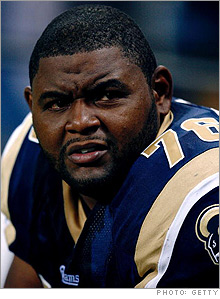Football's quiet millionaires Left tackles don't get a lot of glory, but book by 'Moneyball' author Lewis reveals that they are among the NFL's best-paid players - for good reason. NEW YORK (CNNMoney.com) -- Three years ago Michael Lewis helped change the way average baseball fans and front-office types alike felt about what made a ballplayer valuable. Now he's about to shake up the thinking of football fans with his new book, "The Blind Side."
In his 2003 book "Moneyball," about the front office of the low-revenue Oakland Athletics, Lewis helped to elevate a formerly obscure stat - on-base percentage - to such prominence that it changed the sport's entire salary structure. In 2002, the year Lewis followed the Athletics, players who got on base a lot through walks, rather than hits, could be picked up at bargain prices in the free agent market. And these players' ability to get on base helped Oakland's offense become a bargain-basement winner. The A's made the playoffs for four straight seasons earlier this decade and made it to the American League Championship Series this year before being eliminated. Today, a high on-base percentage equates to a high salary, and the Athletics have been forced to find other obscure measures and rely on increased revenue sharing to continue their relatively low-budget success. Lewis' new book is casting a light on what are probably the most anonymous stars on a football field - offensive left tackles. They play a position that doesn't even show up in the box score. And, like other offensive linemen, their statistics aren't even included in the fantasy football games played by millions of fans. But this position is perhaps the most important of the five offensive lineman spots. That's because the left tackle's job is to block defenders who are coming from the side of the field that a right-handed quarterback can't see, his so called blind side. Lewis' latest book probably won't shake up the salary structure of football the way "Moneyball" helped reshape baseball's salary structure because the market has already quietly adjusted to the left tackle's importance. But it's still surprising even some top football team officials. Lewis discovered when researching the book that the left tackle has become one of the best paid positions on the field. Only starting quarterbacks get a higher average salary than the starting left tackle, and on several teams, the man charged with protecting the quarterback gets more than the man he's paid to protect. For example, the top two paid NFL players in the league last year were quarterbacks: the Falcons' Michael Vick and the Seahawks' Matt Hasselbeck received $23.1 million and $19 million respectively. But the next two highest-paid players were left tackles: the Rams' Orlando Pace, at $18 million, and the Seahawks' Walter Jones, at $17.7 million. "I have talked to many NFL coordinators and coaches and when I said left tackle is the second-best-paid position, their response was, 'No way!'" Lewis said. Lewis told me it's not clear how the market came to place such value on such a low-profile position. Before the advent of free agency in the NFL, left tackles were as poorly paid as the other anonymous members of the offensive line. But Lewis argues that free agency, coupled with the rise of defensive players such as Lawrence Taylor who posed a significant threat to the health of quarterbacks and forced opponents to change their offensive plans, caused the NFL to quickly start paying a premium to the top left tackles. "It's possible that football is mad, that they don't have objective tools to evaluate talent," Lewis said. "It's also possible that the teams respond more to fear, more to the desire to stop bad things from happening than the desire to make good things happen." But Lewis believes the market is rational, and there's a good reason that many left tackles get paid more than the better-known men they are paid to block, and even some of the quarterbacks and running backs they are protecting. He says it's the basic economic law of supply and demand. There aren't many players out there with the combination of size, speed and mobility to play the difficult position. In the NFL today, the position demands someone well in excess of 300 pounds, well over six feet and with relatively little fat and good foot speed. "The pool of people who fit those characteristics is just not that big," he said. His book continually uses the term "freak of nature" to describe several of the left tackles he highlights, from the high school level up to the pros. Sure, it's not necessarily very exciting to spend a game watching a left tackle block a charging defender. But it's not particularly exciting watching a batter work a walk in a baseball game, yet Lewis helped fans and baseball general managers become more focused on that over the past few years. Baseball's flatter playing field |
| ||||||||||||||



